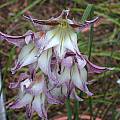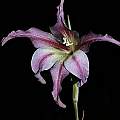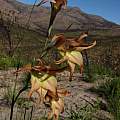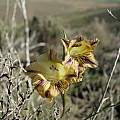Magenta to dark bluish purple is a another focus of Gladiolus diversity. Most of the Eurasian forms can be found here, but there are many South Africans as well.
Page 1: G. arcuatus... Page 3: G. mutabilis... Page 4: G. scullyi...
Gladiolus imbricatus is native to southeastern Europe and Turkey. It grows in wet meadows and marshes and flowers from May to July. It has a dense spike of 4 to 12 pale carmine to deep purple flowers, streaked purple and white. Its lowest leaf is round or blunt, not sharp which is another distinguishing characteristic.
Gladiolus inflatus Thunb. grows in open habitats on sandstone, often in rocky outcrops or in stony ground among shrubs and restios in the mountains of the Western Cape. It has pink to mauve, purple or violet short tubed flowers. The lower tepals have dark spear or spade shaped purple to red marks in the middle third. The mark on the lower median tepal is usually yellow in the center. This species blooms in spring. Photo taken by Rod Saunders.
Gladiolus inflexus Goldblatt & J.C.Manning is endemic to only a few places in the Southwestern Cape where it grows in sandstone derived gravel. Growing from 20 to 35 cm, it has 1 to 3 purple flowers formed on a wiry bent stem. The sweetly scented flowers have a strongly arched dorsal tepal and a large lower median tepal that is greater than the lower laterals. The bases of the tepals and the throat are cream with the lower tepals speckled to blotched purple. Flowering time is mid to late July, sometimes into August. The first photo was taken by Rachel Saunders. The next three were taken by Alan Horstmann.
The next three photos from iNaturalist were taken by Douglas Euston-Brown in July near Worcester and shared under a CC BY-SA license.
Gladiolus italicus has a broad distribution from southern Europe to parts of Asia growing on rocky hillsides, grassy areas, open forests and in fields. It flowers from March to July. Theophrastus wrote that the corm when pounded and mixed with flour made bread sweeter. It is distinguished from other European Gladiolus by having anthers that are longer than the filaments. Flowers are loosely arranged and facing various directions, pale pink as well as purple-pink to magenta with a pale blotch outlined in purple on the lower lobes. There are 5 to 15 flowers on the spike. Photos 1-2 taken by Mary Sue Ittner show the flowers of a plant grown from seed labeled G. italicus. Photo 3 was taken by Nhu Nguyen. Photos 4-6 by M. Gastil-Buhl include a close-up showing the relative length of anthers and stigma, a flower spike and corms still in the clusters as found when excavated against a 1 cm grid. The corms were found growing between 3 to 5 inches deep, including layers of added compost and grit. All of these corms and more grew in 2 years from just 4 juvenile corms.
Photos from Angelo Porcelli. The first is a close-up taken in habitat. The last three photos were taken from his article Gladiolus of Southern Italy. In this article he explains the difference between this species and Gladiolus byzantinus and Gladiolus communis. Gladiolus italicus is smaller, averaging 20 to 23 inches (50-60 cm) and has flowers with an "open" shape; the lateral tepals are oblong, narrow and well spaced, not overlapping the upper tepal and the two lower ones. Seed is quite different in this species from the other two which have winged seed. Seed looks like small pepper grains with three to four angles. Corms have a peculiar net on the tunics, especially on the top of the corm, and are a rather light brown color. This species is highly bulbilliferous and increases by cormlets at an alarming rate and a single corm will turn in a clump in a few years.
Gladiolus kamiesbergensis G.J.Lewis grows in rocky sites in shrubby fynbos in the Kamiesberg of central Namaqualand. From 45-90 cm tall, this species has small, pale, lilac flowers with minute purple dots within and on the reverse of the tepals. The lower lateral tepals are yellow on the lower half of the limbs. This species flowers in spring and the flowers are sweetly scented and probably pollinated by long-tongued bees. Photos taken by Andrew Harvie.
Gladiolus liliaceus Houtt. grows on clay slopes over a wide area of South Africa (from the Cedarberg Mountains to Port Elizabeth) and blooms winter to spring. Growing from 30 to 80 cm high, the 1 to 4, sometimes 6, flowers are an inclined spike. The large flowers are brown, dull pinkish red, tan, purplish or cream to greenish yellow and turn bluish to mauve in the evenings when they become intensely clove scented. Depending on the location and the elevation with the lower elevations blooming earlier, this species blooms from late August to December.
The ones grown by Mary Sue Ittner have not been very fragrant and the color change is subtle. Photo 1 was taken by Mary Sue Ittner. Photos 2-3 from Bob Rutemoeller attempt to show the change in color. Photo 2 was taken during the day and photo 3 in the early evening. Andrew Harvie's photos (4-5) show the orangey red color of the day and the more purple color of the night. To ensure correct color balance both photos were taken with a flash and same exposure. He notes that he wishes he could also share the fragrance.
The forms pictured below in the first four photos were all found at Drayton and were blooming August-September 2003. Photos by Bob Rutemoeller including a single yellow one. The fifth photo is of a red flowered one photographed by Cameron McMaster near Bredasdorp in the Overberg. The last photo from the book Plants of the Klein Karoo courtesy of Jan and Anne Lise Schutte-Vlok.
Gladiolus maculatus Sweet extends across the southern coast and immediate interior of the winter rainfall area to the Eastern Cape where it is often found growing in heavy soils in renosterveld. Flowers are dull yellow to lilac and speckled with brown or purplish spots. They are long-tubed and fragrant during the day and the evening. The first three pictures were taken by Cameron McMaster near Napier and Bredasdorp in the Overberg.
The first two pictures below are of garden flowers taken by Mary Sue Ittner December 2007 and January 2009. The next two were taken by Alan Horstmann and the last by Dirk Wallace.
Gladiolus marlothii G.J.Lewis is endemic to the Roggeveld Escarpment. It grows on open slopes or among rock outcrops, always in heavy clay and usually in rocky situations at an elevation of 1800 m. Flowers are pale blue-lilac with a transverse yellow band about the base of the limb and are densely speckled with dark purple at the edges of the yellow band. Photograph taken by Rod Saunders.
Page 1: G. arcuatus... Page 3: G. mutabilis... Page 4: G. scullyi...









































